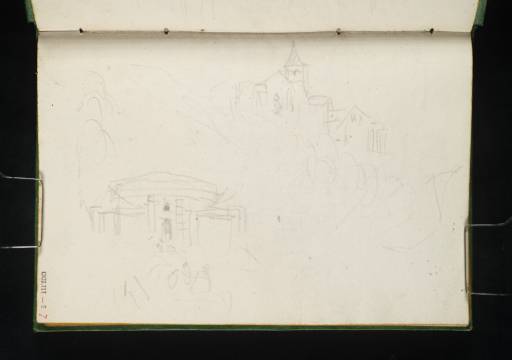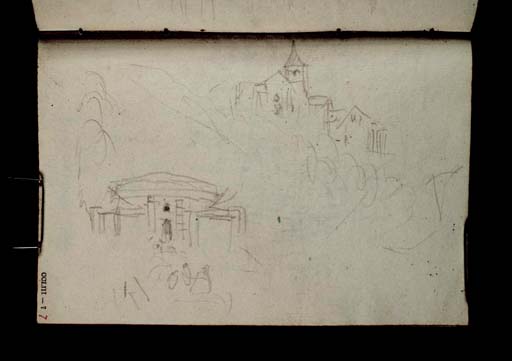Joseph Mallord William Turner Graville and ?Le Havre ?1829
Image 1 of 2
Joseph Mallord William Turner,
Graville and ?Le Havre
?1829
Joseph Mallord William Turner 1775–1851
Folio 7 Recto:
Graville and ?Le Havre ?1829
D23711
Turner Bequest CCLIII 7
Turner Bequest CCLIII 7
Pencil on pale cream laid paper, 107 x 156 mm
Inscribed by John Ruskin in red ink ‘7’ bottom left descending vertically
Stamped in black ‘CCLIII – 7’ bottom left descending vertically
Inscribed by John Ruskin in red ink ‘7’ bottom left descending vertically
Stamped in black ‘CCLIII – 7’ bottom left descending vertically
Accepted by the nation as part of the Turner Bequest 1856
References
1909
A.J. Finberg, A Complete Inventory of the Drawings of the Turner Bequest, London 1909, vol.II, p.768, CCLIII 7, as ‘Graville’.
1999
Ian Warrell, Turner on the Seine, exhibition catalogue, Tate Gallery, London 1999, p.273 under entry for Graville.
The page contains two sketches, both drawn horizontally. Finberg noted this page simply as ‘Graville’1 and the location has been confirmed.2 However the sketch on the top right is identifiable further, by the shape of the buildings depicted, as Graville Abbey; for further information see under folio 6 verso opposite (D23710). Turner depicts the buildings perching on their clifftop location and picks out the abbey’s high church tower, in a little greater detail and darker pencil, as a focal point. In contrast, very light, loose strokes convey the rock or vegetation on which the abbey is located. Art historian Ian Warrell3 mentions that this sketch and D23710 were used as sources for Turner’s later watercolour, Graville, c.1832 (currently untraced),4 engraved for Turner’s Annual Tour – Wanderings by the Seine, 1834 (Tate impressions: T05595, T04700, T06224).
The second sketch appears to depict the entrance of a rounded stone building. Graville Abbey does not seem to have such a building. Graville is a district close to the town of Le Havre and the verso (D23712) depicts the Tower of François I at Le Havre, indicating that Turner travelled there from Graville. Turner’s later watercolour, The Quayside and Tower of François I at Le Havre, Normandy, c.1832 (Tate D24648; Turner Bequest CCLIX 83), shows part of the entrance to the tower which appears very similar to the building depicted in this sketch. It is highly probable therefore that this sketch is of the entrance to the tower. The shapes depicted in front of the building are likely, as in the watercolour, to represent people. (For further information on the tower, see under D23712.)
Caroline South
May 2017
How to cite
Caroline South, ‘Graville and ?Le Havre ?1829 by Joseph Mallord William Turner’, catalogue entry, May 2017, in David Blayney Brown (ed.), J.M.W. Turner: Sketchbooks, Drawings and Watercolours, Tate Research Publication, November 2019, https://www


